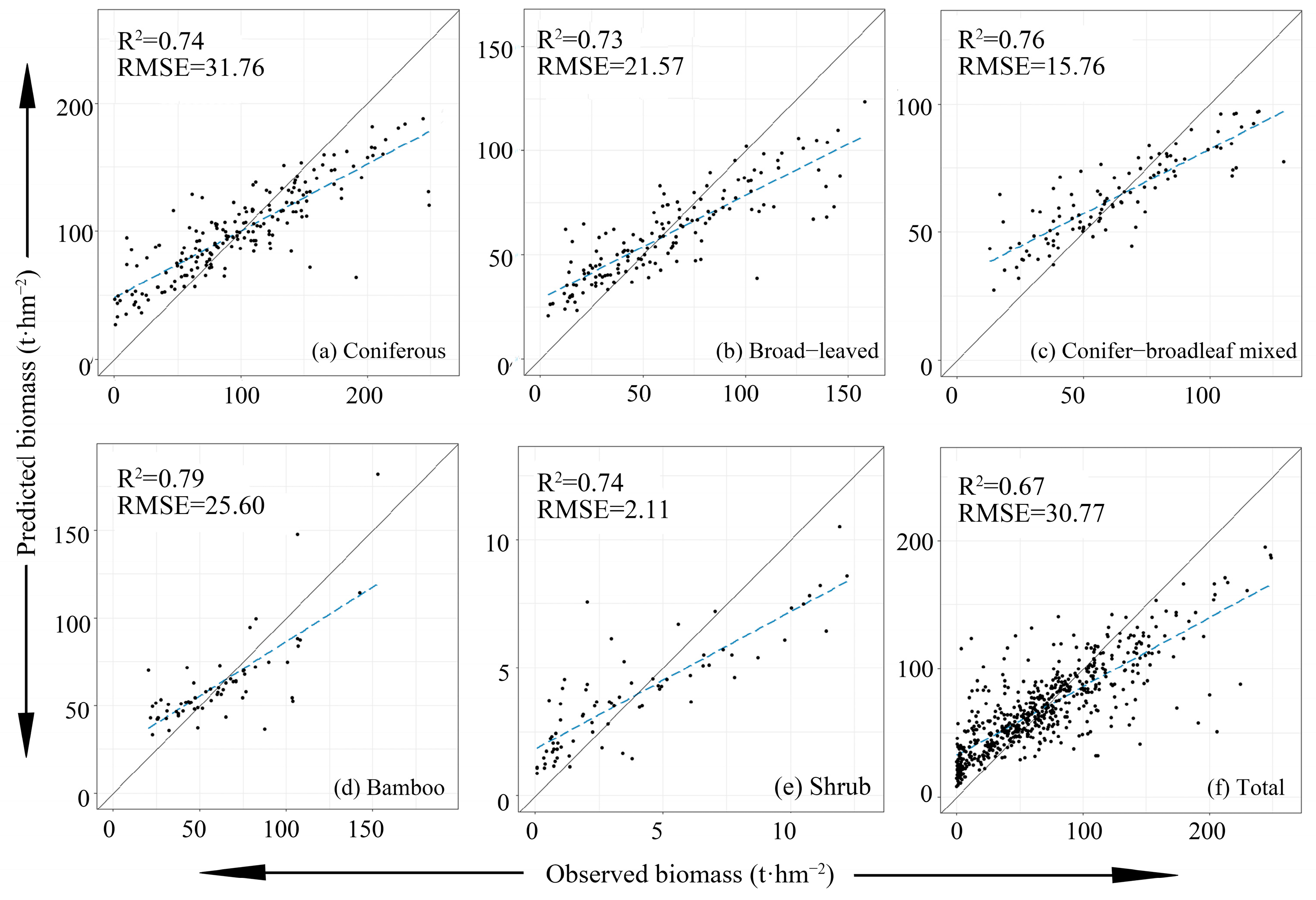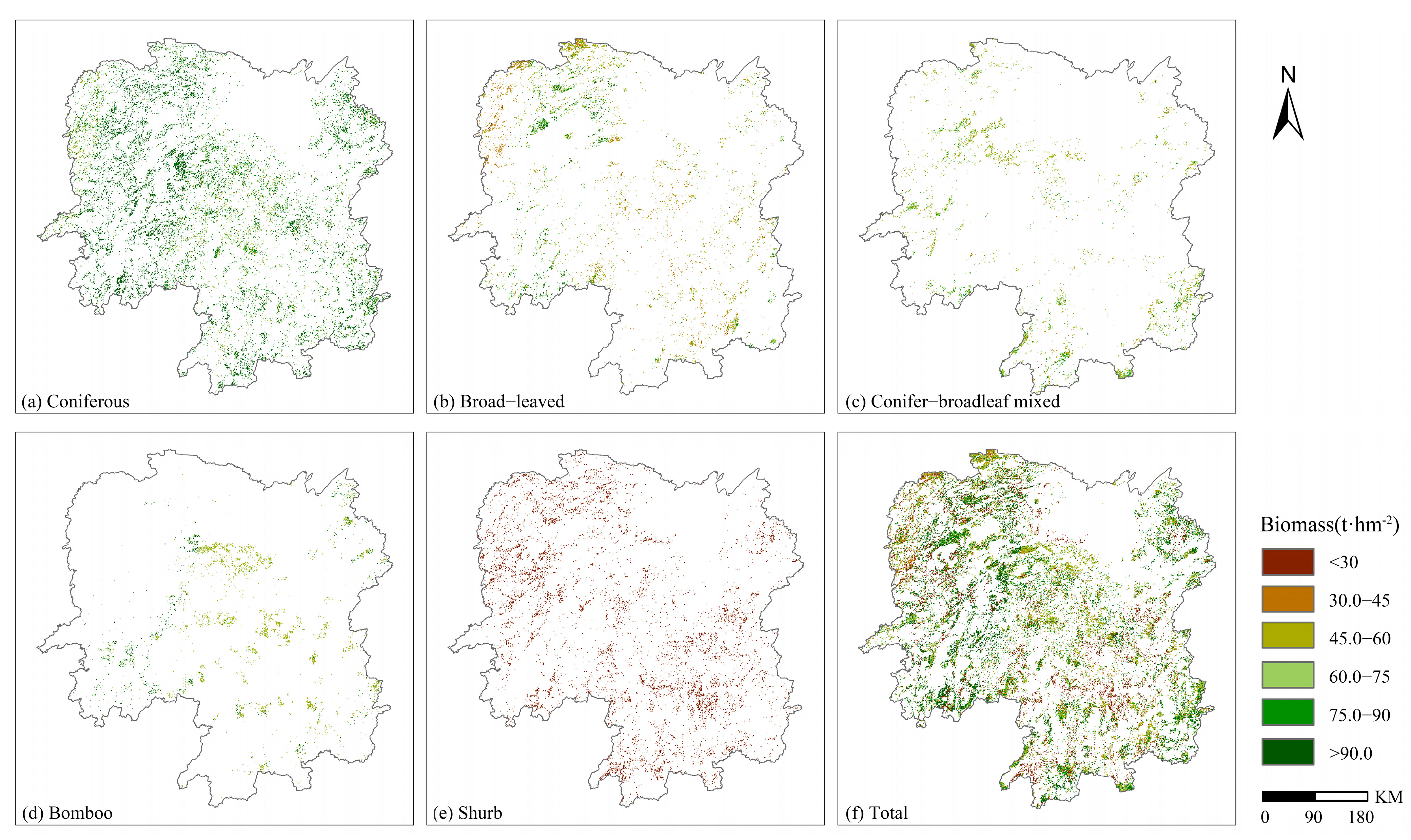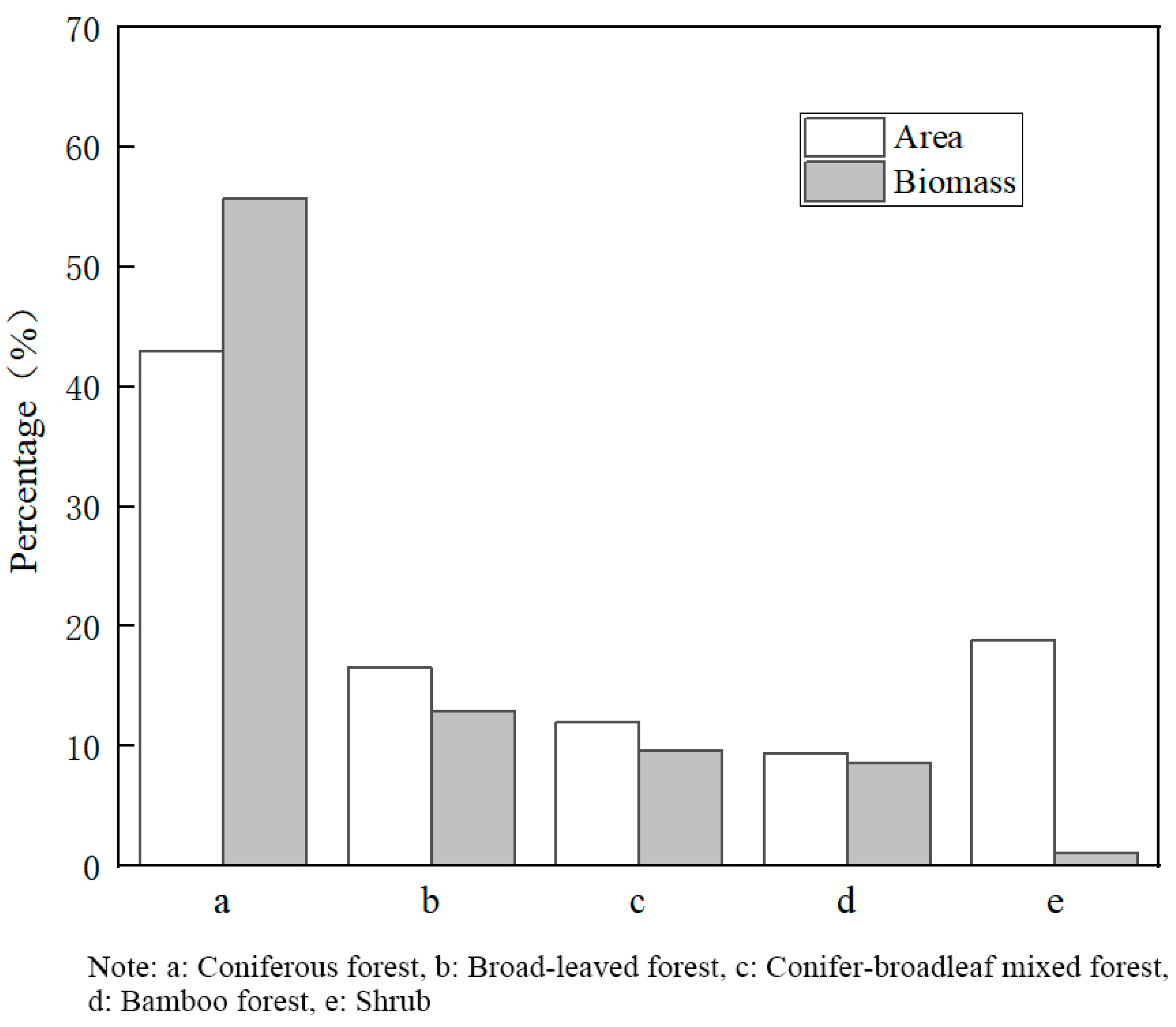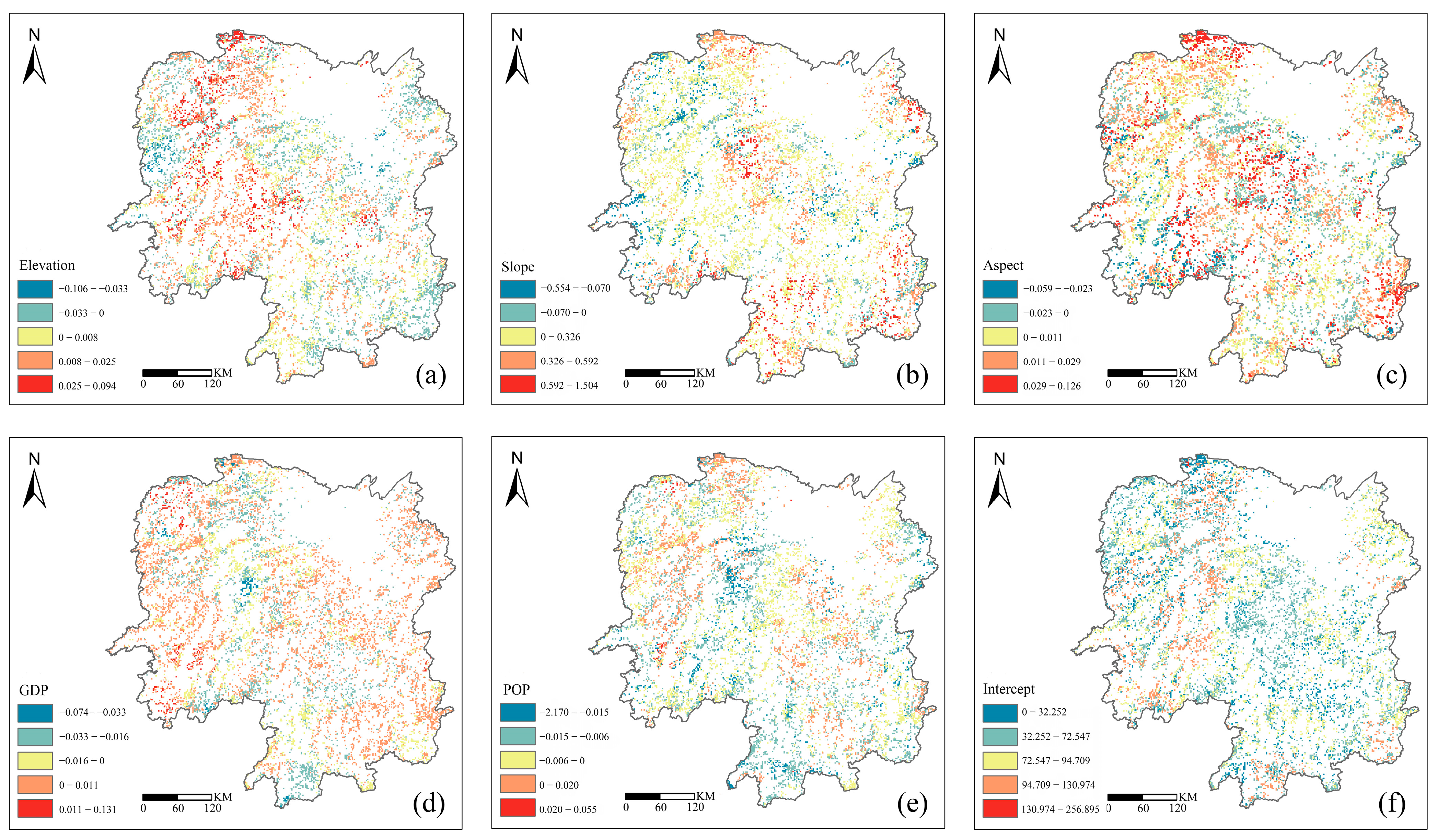Biomass Spatial Pattern and Driving Factors of Different Vegetation Types of Public Welfare Forests in Hunan Province
Abstract
:1. Introduction
2. Materials and Methods
2.1. Study Area
2.2. Data Collection
2.2.1. In Situ Monitoring Data
2.2.2. Remote Sensing Data
2.2.3. Driving Factor Data
2.3. Methods
2.3.1. Methods of Variable Selection
Boruta Algorithm
Ordinary Least Square Method
2.3.2. Random Forest
2.3.3. Geographically Weighted Regression
2.3.4. Evaluation Metrics
3. Results
3.1. Results of Biomass Inversion of Public Welfare Forest
3.2. Spatial Pattern of Biomass of Public Welfare Forest
3.3. Analysis of Results of Geographically Weighted Regression Model
4. Discussion
4.1. Biomass of Different Types of Forests
4.2. Explanatory Power of Driving Factors
4.3. Biomass of Different Types of Public Welfare Forests Are Affected by Driving Factors
5. Conclusions
Author Contributions
Funding
Data Availability Statement
Acknowledgments
Conflicts of Interest
References
- Aguilar, F.X.; Wen, Y. Socio-economic and ecological impacts of China’s forest sector policies. For. Policy Econ. 2021, 127, 102454. [Google Scholar] [CrossRef]
- Zhang, B.; Li, W.; Xie, G. Ecosystem services research in China: Progress and perspective. Ecol. Econ. 2010, 69, 1389–1395. [Google Scholar] [CrossRef]
- Wenhua, L. Degradation and restoration of forest ecosystems in China. For. Ecol. Manag. 2004, 201, 33–41. [Google Scholar] [CrossRef]
- Halme, E.; Pellikka, P.; Mottus, M. Utility of hyperspectral compared to multispectral remote sensing data in estimating forest biomass and structure variables in Finnish boreal forest. Int. J. Appl. Earth Obs. Geoinf. 2019, 83, 101942. [Google Scholar] [CrossRef]
- Zhang, R.; Zhou, X.; Ouyang, Z.; Avitabile, V.; Qi, J.; Chen, J.; Giannico, V. Estimating aboveground biomass in subtropical forests of China by integrating multisource remote sensing and ground data. Remote Sens. Environ. 2019, 232, 111341. [Google Scholar] [CrossRef]
- Wulder, M.A.; Loveland, T.R.; Roy, D.P.; Crawford, C.J.; Masek, J.G.; Woodcock, C.E.; Allen, R.G.; Anderson, M.C.; Belward, A.S.; Cohen, W.B. Current status of Landsat program, science, and applications. Remote Sens. Environ. 2019, 225, 127–147. [Google Scholar] [CrossRef]
- Zhu, Z.; Wulder, M.A.; Roy, D.P.; Woodcock, C.E.; Hansen, M.C.; Radeloff, V.C.; Healey, S.P.; Schaaf, C.; Hostert, P.; Strobl, P. Benefits of the free and open Landsat data policy. Remote Sens. Environ. 2019, 224, 382–385. [Google Scholar] [CrossRef]
- Wulder, M.A.; Roy, D.P.; Radeloff, V.C.; Loveland, T.R.; Anderson, M.C.; Johnson, D.M.; Healey, S.; Zhu, Z.; Scambos, T.A.; Pahlevan, N. Fifty years of Landsat science and impacts. Remote Sens. Environ. 2022, 280, 113195. [Google Scholar] [CrossRef]
- Nguyen, T.H.; Jones, S.; Soto-Berelov, M.; Haywood, A.; Hislop, S. A comparison of imputation approaches for estimating forest biomass using Landsat time-series and inventory data. Remote Sens. 2018, 10, 1825. [Google Scholar] [CrossRef]
- López-Serrano, P.M.; Cárdenas Domínguez, J.L.; Corral-Rivas, J.J.; Jiménez, E.; López-Sánchez, C.A.; Vega-Nieva, D.J. Modeling of aboveground biomass with Landsat 8 OLI and machine learning in temperate forests. Forests 2019, 11, 11. [Google Scholar] [CrossRef]
- Jiang, F.; Sun, H.; Ma, K.; Fu, L.; Tang, J. Improving aboveground biomass estimation of natural forests on the Tibetan Plateau using spaceborne LiDAR and machine learning algorithms. Ecol. Indic. 2022, 143, 109365. [Google Scholar] [CrossRef]
- Li, T.; Zou, Y.; Liu, Y.; Luo, P.; Xiong, Q.; Lu, H.; Lai, C.; Axmacher, J.C. Mountain forest biomass dynamics and its drivers in southwestern China between 1979 and 2017. Ecol. Indic. 2022, 142, 109289. [Google Scholar] [CrossRef]
- Renner, M.; Rembold, K.; Hemp, A.; Fischer, M. Natural regeneration of woody plant species along an elevational and disturbance gradient at Mt. Kilimanjaro. For. Ecol. Manag. 2022, 520, 120404. [Google Scholar] [CrossRef]
- Kucuker, D.M.; Tuyoglu, O. Spatiotemporal patterns and driving factors of carbon dynamics in forest ecosystems: A case study from Turkey. Integr. Environ. Assess. Manag. 2022, 18, 209–223. [Google Scholar] [CrossRef] [PubMed]
- Alves, L.F.; Vieira, S.A.; Scaranello, M.A.; Camargo, P.B.; Santos, F.A.M.; Joly, C.A.; Martinelli, L.A. Forest structure and live aboveground biomass variation along an elevational gradient of tropical Atlantic moist forest (Brazil). For. Ecol. Manag. 2010, 260, 679–691. [Google Scholar] [CrossRef]
- Yu, S.; Ye, Q.; Zhao, Q.; Li, Z.; Zhang, M.; Zhu, H.; Zhao, Z. Effects of Driving Factors on Forest Aboveground Biomass (AGB) in China’s Loess Plateau by Using Spatial Regression Models. Remote Sens. 2022, 14, 2842. [Google Scholar] [CrossRef]
- Park, J.; Lim, B.; Lee, J. Analysis of Factors Influencing Forest Loss in South Korea: Statistical Models and Machine-Learning Model. Forests 2021, 12, 1636. [Google Scholar] [CrossRef]
- Luo, J.; Dai, C.D.; Tian, Y.X.; Peng, P.; Ma, F.F.; Zeng, Z.Q.; Zhou, X.L.; Zhang, M. Establishment of main constructive species biomass model for project forests of carbon sink in Hunan. Hunan For. Sci. Technol. 2016, 43, 12–16+21. [Google Scholar]
- Zeng, Z.Q.; Tian, Y.X.; Dai, C.D.; Peng, P.; Meng, Y.; Huang, Z.R.; Ye, C.J.; Ma, F.F.; Luo, J. Study on biomass model of Phyllostachys heterocycla cv pubescens in Hunan Province. Hunan For. Sci. Technol. 2016, 43, 56–59. [Google Scholar]
- Ma, F.F.; Wu, X.L.; Dai, C.D.; Peng, P.; Tian, Y.X.; Zeng, Z.Q. Construction of individual tree growth model of fast-growing, intermediate and slow growing broadleaf forest in Hunan. Hunan For. Sci. Technol. 2017, 44, 1–7. [Google Scholar]
- Xu, X.; China GDP Spatial Distribution Kilometer Grid Data Set. Data Registration and Publication System of Resources and Environmental Sciences Data Center, Chinese Academy of Sciences. Available online: http://www.resdc.cn/DOI (accessed on 12 February 2022).
- Xu, X.; China Population Spatial Distribution Kilometer Grid Data Set. Data Registration and Publication System of Resources and Environmental Sciences Data Center, Chinese Academy of Sciences. Available online: http://www.resdc.cn/DOI (accessed on 12 February 2022).
- Peng, S. 1-km Monthly Mean Temperature Dataset for China (1901–2021); National Tibetan Plateau Data Center: Beijing, China, 2021. [Google Scholar]
- Peng, S. 1-km Monthly Precipitation Dataset for China (1901–2021); National Tibetan Plateau Data Center: Beijing, China, 2021. [Google Scholar]
- Breiman, L. Random Forests. Mach. Learn. 2001, 45, 5–32. [Google Scholar] [CrossRef]
- Cort, J.W.; Steven, G.A.; Robert, E.D.; Johannes, J.F.; Katherine, M.K.; David, R.L.; O’Donnell, J.; Clinton, M.R. Statistics for the evaluation and comparison of models. J. Geophys. Res. 1986, 33, 250. [Google Scholar]
- Lieth, H.; Whittaker, R.H. Primary Productivity of the Biosphere; Springer: Berlin/Heidelberg, Germany, 1975. [Google Scholar]
- Marchi, M.; Paletto, A.; Cantiani, P.; Bianchetto, E.; Meo, I.D. Comparing thinning system effects on ecosystem services provision in artificial black pine (Pinus nigra JF Arnold) forests. Forests 2018, 9, 188. [Google Scholar] [CrossRef]
- Ma, W.; Liu, Z.; Wang, Z.; Wang, W.; Liang, C.; Tang, Y.; He, J.-S.; Fang, J. Climate change alters interannual variation of grassland aboveground productivity: Evidence from a 22-year measurement series in the Inner Mongolian grassland. J. Plant Res. 2010, 123, 509–517. [Google Scholar] [CrossRef] [PubMed]
- Sun, Z.; Qian, W.; Huang, Q.; Lv, H.; Yu, D.; Ou, Q.; Lu, H.; Tang, X. Use Remote Sensing and Machine Learning to Study the Changes of Broad-Leaved Forest Biomass and Their Climate Driving Forces in Nature Reserves of Northern Subtropics. Remote Sens. 2022, 14, 1066. [Google Scholar] [CrossRef]
- Zhang, L.; Khamphilavong, K.; Zhu, H.; Li, H.; He, X.; Shen, X.; Wang, L.; Kang, Y. Allometric scaling relationships of Larix potaninii subsp. chinensis traits across topographical gradients. Ecol. Indic. 2021, 125, 107492. [Google Scholar] [CrossRef]
- Salinas-Melgoza, M.; Skutsch, M.; Lovett, J. Predicting aboveground forest biomass with topographic variables in human-impacted tropical dry forest landscapes. Ecosphere 2018, 9, 1–20. [Google Scholar] [CrossRef]
- Xu, Y.; Franklin, S.B.; Wang, Q.; Shi, Z.; Luo, Y.; Lu, Z.; Zhang, J.; Qiao, X.; Jiang, M. Topographic and biotic factors determine forest biomass spatial distribution in a subtropical mountain moist forest. For. Ecol. Manag. 2015, 357, 95–103. [Google Scholar] [CrossRef]
- Wang, G.; Guan, D.; Xiao, L.; Peart, M.R. Forest biomass-carbon variation affected by the climatic and topographic factors in Pearl River Delta, South China. J. Environ. Manag. 2019, 232, 781–788. [Google Scholar] [CrossRef]
- Suchar, V.A.; Crookston, N.L. Understory cover and biomass indices predictions for forest ecosystems of the Northwestern United States. Ecol. Indic. 2010, 10, 602–609. [Google Scholar] [CrossRef]
- Wan, Q.; Zhu, G.; Guo, H.; Zhang, Y.; Pan, H.; Yong, L.; Ma, H. Influence of vegetation coverage and climate environment on soil organic carbon in the Qilian Mountains. Sci. Rep. 2019, 9, 17623. [Google Scholar] [CrossRef]
- Ye, Q.; Yu, S.; Liu, J.; Zhao, Q.; Zhao, Z. Aboveground biomass estimation of black locust planted forests with aspect variable using machine learning regression algorithms. Ecol. Indic. 2021, 129, 107948. [Google Scholar] [CrossRef]
- Lin, B.; Ge, J. Does institutional freedom matter for global forest carbon sinks in the face of economic development disparity? China Econ. Rev. 2021, 65, 101563. [Google Scholar] [CrossRef]
- Pentti, H. Utilization of Residual Forest Biomass; Springer: Berlin/Heidelberg, Germany, 1989; pp. 352–477. [Google Scholar]
- Jindi, Z.; Xinliang, W.; Jingjing, Y.; Jiyan, Z. Effects of topographic factors on tree species diversity in subtropical coniferous and broad-leaved mixed forests. J. Nanjing For. Univ. 2022, 46, 153–161. [Google Scholar]
- Chen, W.; Ze, Z.; Qi, G.; Guang, L.; Zhan, L.; Lei, S. Biomass allocation of aboveground components of Phyllostachys edulis and its variation with body size. Chin. J. Ecol. 2014, 33, 2019–2024. [Google Scholar]
- Yu, L. Effect of Different Altitude on Growth of Phyllostachys pubescens in Shouning County. Prot. For. Sci. Technol. 2012, 01, 36–38. [Google Scholar]
- Ni, H.; Su, W.; Fan, S.; Chu, H. Effects of intensive management practices on rhizosphere soil properties, root growth, and nutrient uptake in Moso bamboo plantations in subtropical China. For. Ecol. Manag. 2021, 493, 119083. [Google Scholar] [CrossRef]





| Vegetation Type | Area of Public Welfare Forest (Million hm2) | Percentage (%) | Main Plant Communities |
|---|---|---|---|
| Coniferous forest | 2.14 | 43.16 | Larix gmelinii, Pinus armandii Franch., Pinus massoniana Lamb., Cunninghamia lanceolata, Cupressus funebris, Cryptomeria fortunei, etc. |
| Broadleaf forest | 0.82 | 16.51 | Cinnamomum camphora, Quercus spp., Liquidambar formosana, Sassafras tzumu (Hemsl.) Hemsl., Schima superba Gardn. et Champ, etc. |
| Conifer–broadleaf mixed forest | 0.59 | 11.96 | Pinus massoniana Lamb., Cunninghamia lanceolata, Cupressus funebris, etc. |
| Bamboo forest | 0.47 | 9.43 | Phyllostachys edulis, etc. |
| Shrub | 0.93 | 18.93 | - |
| Total forest | 4.95 | 100 | - |
| Vegetation Type | Sampling Plot Amount | Maximum Biomass (t·hm−2) | Minimum Biomass (t·hm−2) | Mean Biomass (t·hm−2) |
|---|---|---|---|---|
| Coniferous forest | 199 | 324.37 | 0.40 | 107.67 |
| Broadleaf forest | 193 | 198.21 | 3.81 | 72.44 |
| Conifer–broadleaf mixed forest | 139 | 345.66 | 2.92 | 79.62 |
| Bamboo forest | 64 | 415.02 | 20.45 | 65.99 |
| Shrub | 87 | 35.47 | 0.01 | 5.56 |
| Total forest | 682 | 415.02 | 0.01 | 75.04 |
| SV | Definitions of SV | # of SV |
|---|---|---|
| Original band | Coastal aerosol (Band1), blue (Band2), green (Band3), red (Band4), near infrared (Band5), shortwave infrared 1 (Band6), and shortwave infrared 2 (Band7) | 7 |
| Band combinations | Albedo, B4/Albedo, B24 = Band2/Band4, B53 = Band5/Band3, B74 = Band7/Band4, B547 = Band5(Band4/Band7), B345 = Band3(Band4/Band5), and sum visible bands (VIS234) | 8 |
| Image transformations | Principal component analysis (PCA), maximum noise fraction (MNF), high-pass filter (HIP), and low-pass filter (LOP) of seven original bands | 28 |
| Vegetation indices | Normalized difference vegetation index (NDVI), difference vegetation index (DVI), soil adjusted vegetation index (SAVI), simple ratio index (RVI), perpendicular vegetation index (PVI), modified soil adjusted vegetation index (MSAVI), transformation vegetation index (TVI), transformation vegetation index 2 (TVI2), atmospherically resistant vegetation index (ARVI), ND43 = (Band4 − Band3)/(Band4 + Band3), specific leaf area vegetation index (SLAVI), enhanced vegetation index (EVI), green normalized difference vegetation index (GNDVI), modified NLI (MNLI), optimized soil adjusted vegetation index (OSAVI), and renormalized difference vegetation index (RDVI) | 16 |
| Texture measures | Grey-level co-occurrence matrix-based texture measures, including mean, angular second moment, contrast, correlation, dissimilarity, entropy, homogeneity, and variance using moving window sizes of 3 × 3 | 56 |
| Indicator | Indicators Name | Unit | Resolution | Year |
|---|---|---|---|---|
| Topography | Elevation | m | 30 m × 30 m | 2021 |
| Slope | degrees | 30 m × 30 m | 2021 | |
| Aspect | - | 30 m × 30 m | 2021 | |
| Socio-economic | Gross domestic product (GDP) | 103 CNY/km2 | 1 km × 1 km | 2020 |
| Populations (POP) | people/ km2 | 1 km × 1 km | 2020 | |
| Climate | Temperature | °C | 1 km × 1 km | 2021 |
| Precipitation | mm | 1 km × 1 km | 2021 |
| Vegetation Type | Variables Selected |
|---|---|
| Coniferous forest | ARVI, B4,B4/Albedo, B53, B345, GNDVI, MNFB5, NDVI, OSAVI, RVI, SAVI, SLAVI, TVI, PCAB2, PCAB5, HomB5, ConB5, DisB5, VarB6, ConB6, and DisB6 |
| Broadleaf forest | ARVI, B4/Albedo, B53, GNDVI, MNFB2, MNFB7, NDVI, OSAVI, RVI, SAVI, SLAVI, TVI, TVI2, PCAB2, and PCAB6 |
| Conifer–broadleaf mixed forest | B7, B53, MNFB3, MNFB5, SLAVI, PCAB3, PCAB5, and MeaB7 |
| Bamboo forest | ARVI, ND43, SLAVI, PCAB2, HomB7, ConB7, DisB7, EntB7, ASMB7 |
| Shrub | ARVI, B24, MeaB7, RDVI1, and SLAVI |
| Total forest | Albedo, ARVI, B2, B3, B4, B4/Albedo, B6, B7, B53, B74, B345, B547, DVI, EVI, GNDVI, MNFB2, MNFB3, MNFB5, MSAVI, ND43, NDVI, OSAVI, PVI, RDVI1, RVI, SAVI, SLAVI, TVI, TVI2, VIS234, PCAB1, PCAB2, PCAB4, PCAB5, MeaB5, MeaB6, and MeaB7 |
| Vegetation Type | Mean Biomass (t·hm−2) | Biomass (Million Tons) | Percentage (%) |
|---|---|---|---|
| Coniferous forest | 100.33 | 215.24 | 63.62 |
| Broadleaf forest | 59.27 | 48.45 | 14.32 |
| Conifer–broadleaf mixed forest | 62.44 | 36.97 | 10.93 |
| Bamboo forest | 71.33 | 33.32 | 9.85 |
| Shrub | 4.65 | 4.33 | 1.28 |
| Total forest | 68.31 | 338.31 | 100.00 |
| Vegetation Type | Driving Factors | VIF | p Value |
|---|---|---|---|
| Coniferous forest | Elevation | 1.260 | 0.000 |
| Slope | 1.150 | 0.000 | |
| POP | 1.111 | 0.000 | |
| Aspect | 1.000 | 0.000 | |
| GDP | 1.065 | 0.001 | |
| Broadleaf forest | Elevation | 1.024 | 0.000 |
| POP | 1.039 | 0.038 | |
| GDP | 1.057 | 0.041 | |
| Conifer–broadleaf mixed forest | Elevation | 1.152 | 0.000 |
| Aspect | 1.000 | 0.000 | |
| GDP | 1.066 | 0.007 | |
| POP | 1.094 | 0.104 | |
| Slope | 1.094 | 0.736 | |
| Bamboo forest | Elevation | 1.154 | 0.000 |
| GDP | 1.061 | 0.000 | |
| POP | 1.056 | 0.015 | |
| Shrub | Slope | 1.231 | 0.000 |
| GDP | 1.030 | 0.000 | |
| POP | 1.061 | 0.001 | |
| Aspect | 1.001 | 0.020 |
| Regression Coefficient of Coniferous Forest | Regression Coefficient of Conifer–Broadleaf Mixed Forest | ||||||||||||
| Min | Lower-Quartile | Median | Mean | Upper-Quartile | Max | Min | Lower-Quartile | Median | Mean | Upper-Quartile | Max | ||
| Intercept | 56.117 | 75.917 | 95.178 | 89.009 | 115.518 | 135.319 | Intercept | 37.619 | 46.982 | 56.345 | 62.188 | 65.708 | 75.070 |
| Elevation | −0.849 | −0.049 | −0.015 | 0.010 | 0.020 | 0.055 | Elevation | −0.029 | −0.018 | −0.007 | −0.001 | 0.003 | 0.014 |
| Slope | −0.537 | −0.156 | 0.225 | 0.303 | 0.606 | 0.988 | Slope | −0.236 | −0.032 | 0.171 | 0.016 | 0.375 | 0.579 |
| Aspect | −0.025 | 0.009 | 0.042 | 0.022 | 0.076 | 0.109 | Aspect | −0.016 | −0.005 | 0.006 | 0.008 | 0.018 | 0.029 |
| POP | −0.030 | −0.014 | 0.002 | −0.003 | 0.019 | 0.036 | POP | −0.038 | −0.025 | −0.013 | −0.003 | 0.004 | 0.013 |
| GDP | −0.074 | −0.045 | −0.016 | −0.004 | 0.013 | 0.043 | GDP | −0.023 | −0.015 | −0.008 | −0.004 | −0.000 | 0.007 |
| R2 = 0.29 | AICc = 161,796.21 | R2 = 0.39 | AICc = 56,279.68 | ||||||||||
| Regression Coefficient of Broadleaf Forest | Regression Coefficient of Bamboo Forest | ||||||||||||
| Min | Lower-Quartile | Median | Mean | Upper-Quartile | Max | Min | Lower-Quartile | Median | Mean | Upper-Quartile | Max | ||
| Intercept | 14.06 | 31.329 | 48.602 | 56.179 | 65.875 | 83.148 | Intercept | 32.180 | 52.224 | 72.267 | 66.305 | 92.310 | 112.364 |
| Elevation | −0.048 | −0.028 | −0.008 | 0.003 | 0.011 | 0.031 | Elevation | −0.106 | −0.063 | −0.019 | 0.009 | 0.025 | 0.069 |
| POP | −0.060 | −0.042 | −0.024 | −0.008 | −0.006 | 0.0122 | POP | −2.170 | −1.584 | −0.999 | −0.010 | −0.413 | 0.173 |
| GDP | −0.116 | −0.005 | 0.000 | 0.000 | 0.007 | 0.013 | GDP | −0.035 | 0.006 | 0.048 | −0.001 | 0.089 | 0.131 |
| R2 = 0.27 | AICc = 58,586.15 | R2 = 0.41 | AICc = 32,622.50 | ||||||||||
| Regression Coefficient of Shrub Forest | Regression Coefficient of Total Forest | ||||||||||||
| Min | Lower-Quartile | Median | Mean | Upper-Quartile | Max | Min | Lower-Quartile | Median | Mean | Upper-Quartile | Max | ||
| Intercept | −5.282 | 1.885 | 4.299 | 4.205 | 6.712 | 9.126 | Intercept | −7.7434 | 41.8186 | 71.9099 | 70.8741 | 99.0510 | 142.7129 |
| Slope | −0.078 | −0.027 | 0.024 | 0.022 | 0.075 | 0.126 | Elevation | −0.0772 | −0.0238 | −0.0006 | 0.0001 | 0.0224 | 0.1068 |
| Aspect | −0.005 | −0.002 | 0.000 | 0.001 | 0.002 | 0.005 | Slope | −0.9861 | −00.240 | 0.1143 | 0.0808 | 0.5353 | 1.4539 |
| POP | −0.005 | −0.003 | −0.001 | −0.001 | 0.002 | 0.004 | Aspect | −0.0463 | −0.0072 | 0.0085 | 0.0078 | 0.0233 | 0.0588 |
| GDP | −0.010 | −0.006 | −0.003 | −0.001 | 0.000 | 0.004 | POP | −0.0785 | −0.0224 | −0.0077 | −0.0053 | 0.0044 | 0.0316 |
| R2 = 0.48 | AICc = 29,331.82 | GDP | −0.1260 | −0.0174 | 0.0145 | −0.0010 | 0.0635 | 0.1281 | |||||
| Elevation | GDP | |||||||||
| <−0.033 | [−0.033, 0) | [0, 0.008) | [0.008, 0.025) | >0.025 | <−0.033 | [−0.033, −0.016) | [−0.016, 0) | [0, 0.011) | >0.011 | |
| Coniferous forest | 2.33 | 21.91 | 18.61 | 39.71 | 17.43 | 2.98 | 8.27 | 48.38 | 37.41 | 2.96 |
| Broadleaf forest | 0.78 | 47.88 | 8.54 | 32.84 | 9.97 | - | - | 45.37 | 54.09 | 0.54 |
| Conifer–broadleaf mixed forest | - | 49.44 | 43.27 | 7.29 | - | - | 9.16 | 66.73 | 24.11 | - |
| Bamboo forest | 0.50 | 27.50 | 34.70 | 17.90 | 19.40 | - | 5.70 | 58.60 | 26.70 | 9.00 |
| Shrub | - | - | - | - | - | - | 0 | 66.03 | 35.97 | 0 |
| Total forest | 1.26 | 36.23 | 24.44 | 25.69 | 12.38 | 1.55 | 5.54 | 53.51 | 37.07 | 2.33 |
| Aspect | Slope | |||||||||
| <−0.023 | [−0.023, 0) | [0, 0.011) | [0.011, 0.029) | >0.029 | <−0.070 | [−0.070, 0) | [0, 0.326) | [0.326, 0.592) | >0.592 | |
| Coniferous forest | 0.10 | 4.61 | 13.30 | 49.90 | 32.09 | 6.83 | 5.42 | 39.84 | 32.72 | 15.18 |
| Conifer–broadleaf mixed forest | - | 23.74 | 33.83 | 42.24 | 0.19 | 17.45 | 37.68 | 43.91 | 0.96 | - |
| Shrub | - | 36.25 | 63.75 | - | - | - | 14.31 | 85.69 | 0 | - |
| Total forest | 5.54 | 0.57 | 30.21 | 29.35 | 34.32 | 9.31 | 13.90 | 50.20 | 19.12 | 7.48 |
| POP | Intercept | |||||||||
| <−0.015 | [−0.015, −0.006) | [−0.006, 0) | [0, 0.020) | >0.020 | [0, 32.25) | [32.25, 72.55) | [72.55, 94.71) | [94.71, 130.98) | >130.974 | |
| Coniferous forest | 5.99 | 22.28 | 41.96 | 29.27 | 0.50 | - | 15.34 | 48.89 | 35.56 | 0.21 |
| Broadleaf forest | 15.04 | 23.48 | 42.32 | 19.16 | - | - | 79.85 | 20.15 | - | - |
| Conifer–broadleaf mixed forest | - | 3.65 | 28.25 | 35.08 | 33.02 | - | 89.25 | 10.75 | - | 0 |
| Bamboo forest | 11.99 | 20.50 | 40.48 | 21.66 | 5.36 | 72.02 | 25.00 | 2.98 | - | - |
| Shrub | - | - | 92.09 | 7.91 | - | 100 | - | - | - | - |
| Total forest | 7.48 | 20.08 | 48.58 | 23.24 | 0.63 | 19.75 | 34.88 | 24.15 | 16.26 | 4.97 |
Disclaimer/Publisher’s Note: The statements, opinions and data contained in all publications are solely those of the individual author(s) and contributor(s) and not of MDPI and/or the editor(s). MDPI and/or the editor(s) disclaim responsibility for any injury to people or property resulting from any ideas, methods, instructions or products referred to in the content. |
© 2023 by the authors. Licensee MDPI, Basel, Switzerland. This article is an open access article distributed under the terms and conditions of the Creative Commons Attribution (CC BY) license (https://creativecommons.org/licenses/by/4.0/).
Share and Cite
Liu, H.; Fu, Y.; Pan, J.; Wang, G.; Hu, K. Biomass Spatial Pattern and Driving Factors of Different Vegetation Types of Public Welfare Forests in Hunan Province. Forests 2023, 14, 1061. https://doi.org/10.3390/f14051061
Liu H, Fu Y, Pan J, Wang G, Hu K. Biomass Spatial Pattern and Driving Factors of Different Vegetation Types of Public Welfare Forests in Hunan Province. Forests. 2023; 14(5):1061. https://doi.org/10.3390/f14051061
Chicago/Turabian StyleLiu, Huiting, Yue Fu, Jun Pan, Guangjun Wang, and Kongfei Hu. 2023. "Biomass Spatial Pattern and Driving Factors of Different Vegetation Types of Public Welfare Forests in Hunan Province" Forests 14, no. 5: 1061. https://doi.org/10.3390/f14051061





